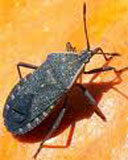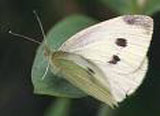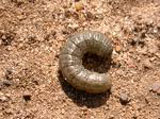Rogue's Gallery
Click on the image for information about the bug!
Bug Information
 Tomato Hornworm Tomato Hornworms and Tobacco Hornworms look similar and both attack tomatoes, peppers, eggplants,potatoes etc. The tomato hornworm is three to four inches long at full size (likely to be the biggest caterpillar we see in our gardens) and green in color with white v-shaped marks along its sides. A black "horn" projects from the rear of the caterpillar. Tobacco hornworms have diagonal white stripes and a red "horn."
Tomato Hornworm Tomato Hornworms and Tobacco Hornworms look similar and both attack tomatoes, peppers, eggplants,potatoes etc. The tomato hornworm is three to four inches long at full size (likely to be the biggest caterpillar we see in our gardens) and green in color with white v-shaped marks along its sides. A black "horn" projects from the rear of the caterpillar. Tobacco hornworms have diagonal white stripes and a red "horn."
Hornworms are well camouflaged even though large, and undetected can do a fair amount of damage to its host plant. They have hearty appetites, and can defoliate a plant in a matter of days. If they are detected and removed early on, the plant should recover. Stubs where the leaves were on a stem are a good indicator that a hornworm is nearby. Back to thumbnail
 Squash bug Squash bugs mainly attack squash and pumpkins but can also attack other cucurbits, such as cucumbers. Squash bug adults overwinter in sheltered places, such as under plant debris, around buildings, or under rocks. When they emerge in the spring, they fly to growing cucurbit plants to feed and mate. Female squash bugs lay eggs individually in small clusters of about 20 commonly on the undersides of the leaves, especially between the veins where they form a V. Eggs may also be deposited on stems. The females appear in gardens in early June and lay eggs through mid-summer.
Eggs hatch in about 10 days. Nymphs take about four to six weeks to mature into adults. Both adults and nymphs scurry for cover when disturbed, and usually hide from view on the undersides of leaves or stems. One generation develops each year, although it is possible that in some summers there is a partial second generation. The life stages overlap and all of them can be seen at any given time during the growing season. If left unchecked, a large colony can develop. After the vines have died, they can congregate on squash fruits and attack them. The nymphs die when the temperatures drop to freezing but the adults survive in sheltered places.
Squash bug Squash bugs mainly attack squash and pumpkins but can also attack other cucurbits, such as cucumbers. Squash bug adults overwinter in sheltered places, such as under plant debris, around buildings, or under rocks. When they emerge in the spring, they fly to growing cucurbit plants to feed and mate. Female squash bugs lay eggs individually in small clusters of about 20 commonly on the undersides of the leaves, especially between the veins where they form a V. Eggs may also be deposited on stems. The females appear in gardens in early June and lay eggs through mid-summer.
Eggs hatch in about 10 days. Nymphs take about four to six weeks to mature into adults. Both adults and nymphs scurry for cover when disturbed, and usually hide from view on the undersides of leaves or stems. One generation develops each year, although it is possible that in some summers there is a partial second generation. The life stages overlap and all of them can be seen at any given time during the growing season. If left unchecked, a large colony can develop. After the vines have died, they can congregate on squash fruits and attack them. The nymphs die when the temperatures drop to freezing but the adults survive in sheltered places.
Squash bugs suck the sap out of leaves. This causes yellow spots that eventually turn brown. The feeding disrupts the flow of water and nutrients and the leaves and stems dry and die. Young plants are much more susceptible to damage but large infestations can kill even mature plants.
The most important times to control squash bugs are when the plants are young seedlings and when they are flowering. Early detection of eggs and nymphs is important, as adult squash bugs have harder bodies and are more difficult to kill. Squash bugs are less important to control later in the growing season when fruits have matured.
Back to thumbnail
 Cabbage White Butterfly The butterfly has off-white wings, with one or two grayish-black spots per wing. The wingspan is roughly two inches across. The larva (which is the form that does the actual damage)is a velvety green, inchworm-type caterpillar that is roughly one inch long. Eggs will be found on the undersides of leaves, and are yellow and oval-shaped.
Cabbage White Butterfly The butterfly has off-white wings, with one or two grayish-black spots per wing. The wingspan is roughly two inches across. The larva (which is the form that does the actual damage)is a velvety green, inchworm-type caterpillar that is roughly one inch long. Eggs will be found on the undersides of leaves, and are yellow and oval-shaped.
Because of their voracious appetite, an "infestation" can be as few as two or three worms per plant. Look for holes being chewed from the centers of leaves in kale and cabbage, as well as entry holes chewed to the interior of heads of cabbage. In particular, look on the undersides of leaves, because this is where the cabbage worms usually hang out. They also produce dark green droppings that are fairly noticeable.
Check your plants frequently for worms, especially if you have seen the butterflies nearby. Check plants thoroughly, and hand-pick and destroy any worms you find. If you have a serious infestation, purchase bacillus thuringiensis (BT) and apply it according to the directions. To prevent infestation in the first place, protect your plants with floating row covers, especially in spring and early summer, when egg-laying activity is at its highest.
To prevent the worms from burrowing into cabbage heads, insert each head into a nylon stocking, and leave it on until you harvest the head.
Back to thumbnail
 Cutworm The cutworm is fat, rather greasy-looking, and measures one to two inches in length. Cutworm damage is unmistakable: plants are severed at or near the surface of the soil. They will occasionally eat the entire plant. They attack early vegetable and flower seedlings and transplants at night, so it is unlikely you will see them during the day. If you notice cutworm damage, dig around in the soil near the affected plants. They will destroy several seedlings in an evening and will make short work of a row unless you find them. If you are using a floating row cover, check your seedlings underneath it regularly!
Cutworm The cutworm is fat, rather greasy-looking, and measures one to two inches in length. Cutworm damage is unmistakable: plants are severed at or near the surface of the soil. They will occasionally eat the entire plant. They attack early vegetable and flower seedlings and transplants at night, so it is unlikely you will see them during the day. If you notice cutworm damage, dig around in the soil near the affected plants. They will destroy several seedlings in an evening and will make short work of a row unless you find them. If you are using a floating row cover, check your seedlings underneath it regularly!
The best way to protect young plants from cutworms is to sink a section of straw into the ground against the stem or place a paper or cardboard collar around your seedlings and transplants. Toilet paper tubes work well. Press the collars down into the soil an inch or so. You can remove these collars later in the season when the plants are mature. Back to thumbnail



